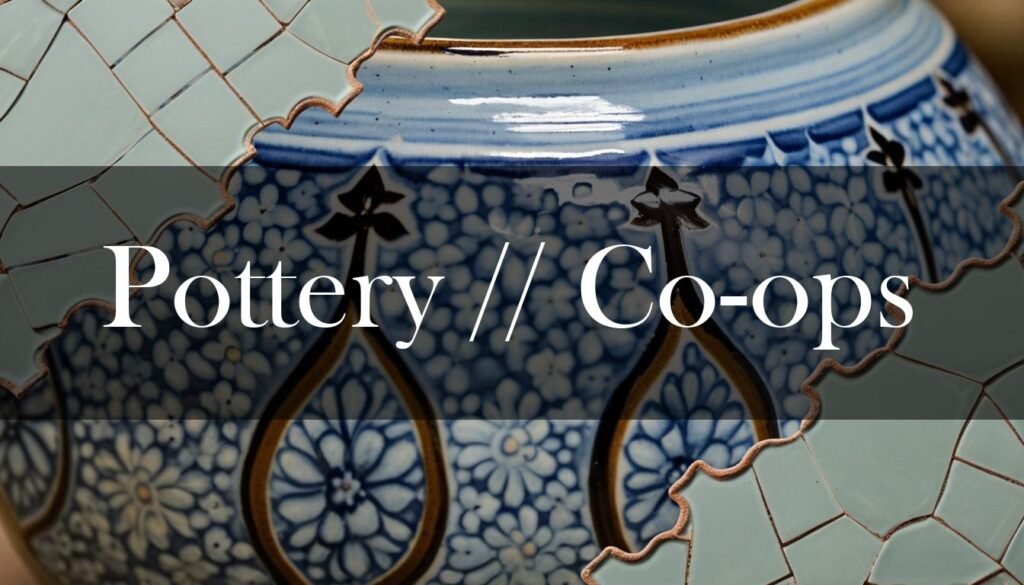Pottery cooperatives and guilds represent vibrant communities where ceramic artists come together to share resources, knowledge, and a passion for clay. These organizations play a crucial role in fostering artistic growth, providing economic advantages, and preserving the rich traditions of pottery. Whether you’re a seasoned potter or just beginning to explore the craft, being part of a cooperative or guild can significantly enrich your artistic journey. You might even find a class near you – here’s a guide to teaching pottery classes.
One of the most significant benefits of joining a pottery cooperative is access to shared resources and facilities. Equipment like pottery wheels, kilns, and slab rollers can be expensive, making it challenging for individual artists to afford them. Cooperatives pool resources, allowing members to use these tools for a fraction of the cost. For example, the Clay Co-op in St. Petersburg offers its members access to a variety of equipment, making pottery more accessible to aspiring and established artists alike. Beyond equipment, cooperatives often offer educational opportunities through classes and workshops. The Urban Art Co-op in Spokane provides eight-week courses that include instruction, tools, and clay, fostering skill development in a supportive environment. These educational initiatives not only enhance technical skills but also encourage experimentation and innovation.
Pottery guilds have a rich history, dating back to medieval Europe where they regulated and protected artisans’ interests. In the Netherlands, the Guild of Saint Luke included potters, and as the Delftware industry grew, potters gained greater representation within the guild. In the United Kingdom, pottery unions like the Ceramic and Allied Trades Union (CATU) fought for workers’ rights and better working conditions. Today, guilds like the Scottish Potters Association (SPA) continue to foster community and promote ceramic arts through exhibitions, workshops, and annual events. Famous pottery cooperatives such as Pewabic Pottery in Detroit, known for its iridescent glazes and architectural tiles, and Bennington Potters in Vermont, which began as an artists’ cooperative creating functional stoneware, demonstrate the lasting impact of these collaborative efforts. These cooperatives have not only produced remarkable ceramics but have also contributed significantly to their local communities and the broader art world.
“Pottery cooperatives and guilds are more than just places to create; they are communities where artists support each other, share knowledge, and push the boundaries of ceramic art.”
Starting your own pottery cooperative involves several key steps. First, gather a dedicated core group with diverse skills and a shared vision. Develop a clear mission statement to guide your cooperative’s purpose and values. Establish a legal and financial structure, choosing a business form like an LLC to protect members and define ownership. Secure a suitable location and acquire the necessary equipment and supplies. Define membership criteria and fees, and plan activities like workshops and exhibitions to promote your cooperative. A well-thought-out marketing strategy, including a website and social media presence, is essential for reaching a wider audience. Remember to foster a collaborative environment that encourages open communication and mutual support. Check out this article about selling pottery online.
- Gather a Core Group: Assemble a team with diverse skills and a shared passion for pottery.
- Develop a Mission Statement: Define your cooperative’s purpose and values.
- Establish a Legal Structure: Choose a business form like an LLC to protect members.
- Secure a Location: Find a suitable space with the necessary facilities.
- Define Membership: Set criteria and fees for joining the cooperative.
- Plan Activities: Organize workshops and exhibitions to promote your work.
- Market Your Cooperative: Create a website and social media presence.
- Foster Collaboration: Encourage open communication and mutual support.
The legal structure of a pottery cooperative is crucial for its operation and sustainability. Cooperatives typically adopt a traditional business form such as a corporation, LLC, or nonprofit organization. Each structure offers different benefits, including limited liability, tax advantages, and flexibility. Some states even have specific statutes for cooperatives, like the Limited Cooperative Association (LCA), which blends cooperative principles with elements of partnerships and LLCs. Consulting with legal professionals experienced in cooperative law can help you navigate state-specific regulations and ensure your cooperative’s structure aligns with its goals and values. Whether you’re looking to join an existing cooperative or start your own, these communities offer invaluable opportunities for artistic growth, collaboration, and the preservation of ceramic arts.





